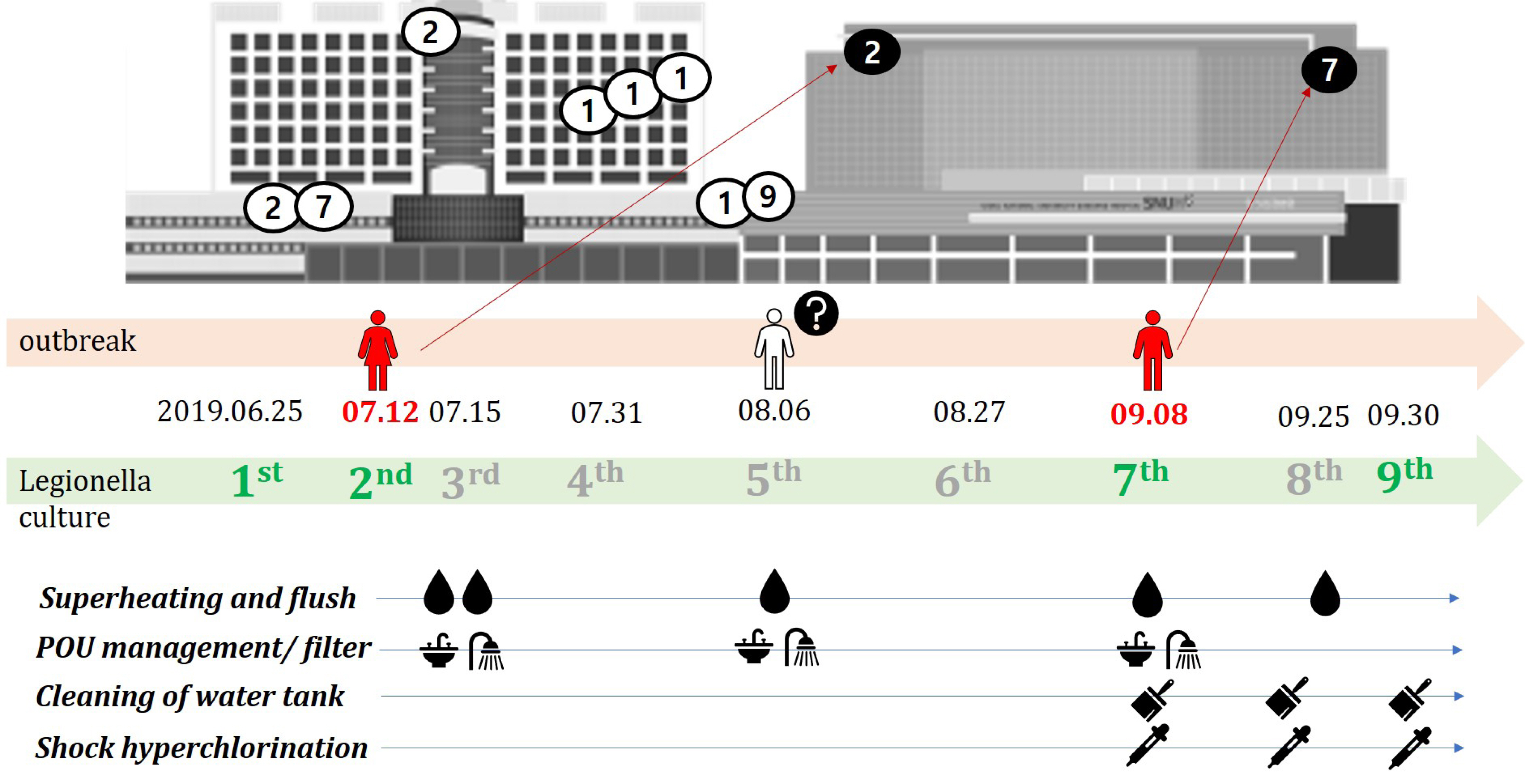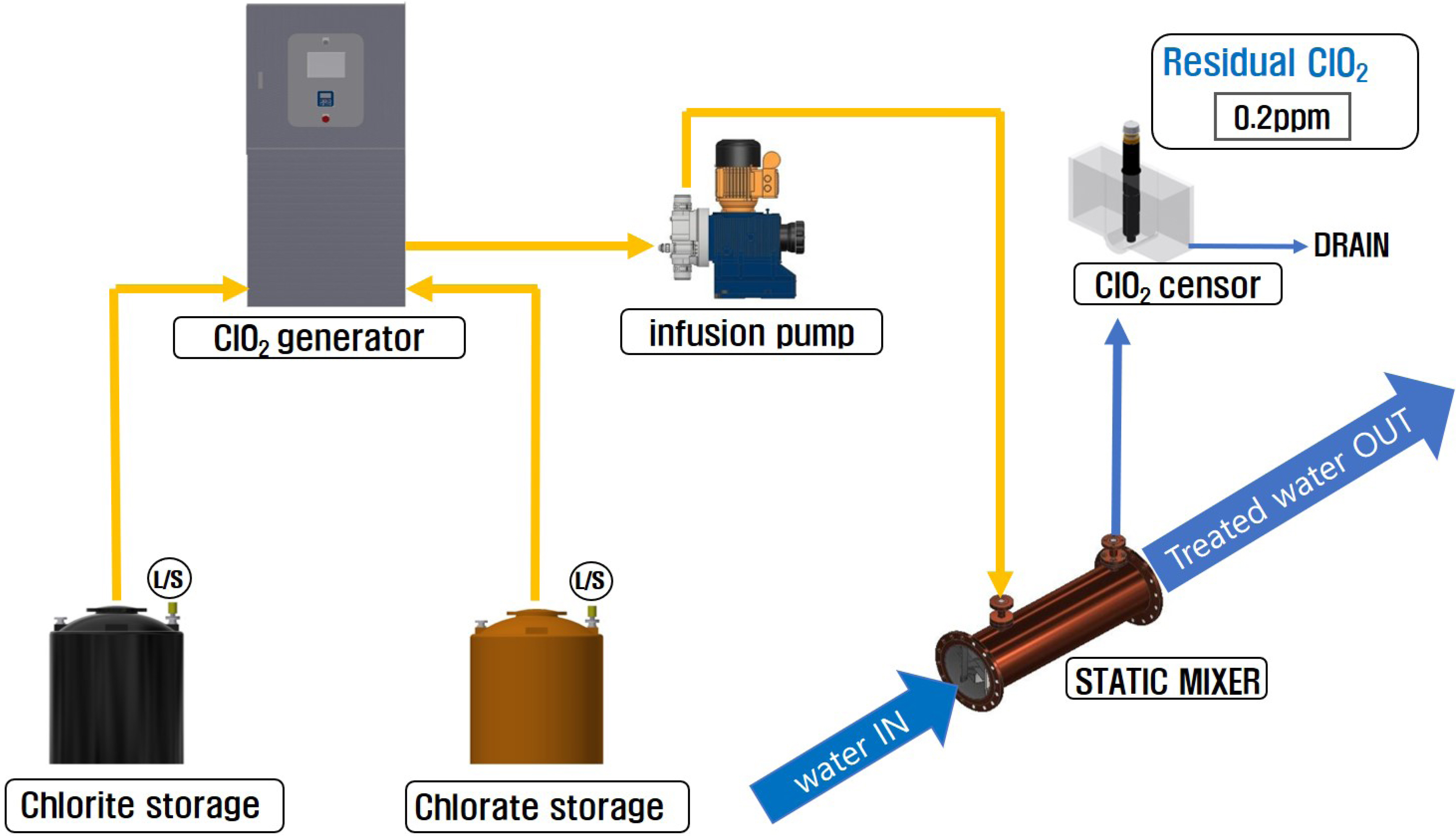Korean J healthc assoc Infect Control Prev.
2023 Jun;28(1):135-142. 10.14192/kjicp.2023.28.1.135.
Outbreak of Nosocomial Legionellosis Managed by Adoption of Chlorine Dioxide Infusion System
- Affiliations
-
- 1Division of Infectious Disease, Department of Internal Medicine, Seoul National University Bundang Hospital, Seongnam, Korea
- 2Infection Control Center, Seoul National University Bundang Hospital, Seongnam, Korea
- 3Seoul National University College of Medicine, Seoul, Korea
- 4Department of Laboratory Medicine, Seoul National University Bundang Hospital, Seongnam, Korea
- 5Construction & Engineering Team, Seoul National University Bundang Hospital, Seongnam, Korea
- KMID: 2543144
- DOI: http://doi.org/10.14192/kjicp.2023.28.1.135
Abstract
- Background
Close surveillance of Legionella in the plumbing systems of medical institutions is required because of the higher morbidity and mortality of nosocomial legionellosis. We experienced an outbreak of legionellosis in a university hospital, managed with a chlorine dioxide infusion system.
Methods
Multiple contaminations with Legionella were reported in the annual water surveillance in June 2019. A task force was established to prevent the outbreak of legionellosis, and the entire plumbing system of the hospital was investigated. Initial measurement was done according to the action manual of the Korean Disease Control and Prevention Agency, including cleaning of hot water tanks, superheating and flushing, point-of-use management (change of showerheads and taps on washstands), and application of filters in higher-risk areas. Further shock hyperchlorination for the cooling tower and cleaning of the water tank were performed since persistent contamination was reported in these areas. Nevertheless, there was an outbreak of three presumable cases of in-hospital legionellosis. A continuous infusion of chlorine dioxide (ClO2 ) was planned to decontaminate the hospital’s plumbing. Equipment for ClO2 infusion was installed by May 2020, with terminal monitors of residual chlorine and a feedback system. A repeated environmental culture study was also planned. Furthermore, a preemptive surveillance system including active monitoring for patients tested with Legionella urinary antigen was developed, and a newer response manual for legionellosis was distributed.
Results
Isolation of Legionella in hospital water was first noted in June 2019. Since then, Legionella has been identified in 6 out of 47 samples in five surveillances by the public health center. Furthermore, 6 out of 85 samples were reported to be positive for Legionella by inhospital water cultures. Two patients were diagnosed with nosocomial legionellosis within 3 months of the initial response. After the installation of the ClO2 continuous infusion system in May 2020, no isolation of Legionella was reported in the next two whole environmental surveillance. No further cases of bacterial inoculation or Legionella infections have been reported so far.
Conclusion
The outbreak of nosocomial legionellosis was successfully terminated with the continuous infusion of ClO2 into the premise plumbing system of the hospital. Sporadic outbreaks of hospital-acquired legionellosis have continued; therefore, individualized reinforcement of the response system to prevent nosocomial legionellosis is required.
Keyword
Figure
Reference
-
1. Sabria M, Yu VL. 2002; Hospital-acquired legionellosis: solutions for a preventable infection. Lancet Infect Dis. 2:368–73. DOI: 10.1016/S1473-3099(02)00291-8. PMID: 12144900.
Article2. Korea Disease Control. Guidelines for the management of legionellosis, 2023. https://www.kdca.go.kr/board/board.es?mid=a20507020000&bid=0019. (Updated on 6 April 2023).3. Bartram J, Chartier Y, Lee JV, Pond K, Surman-Lee S. 2007. Legionella and the prevention of legionellosis. World Health Organization;Geneva: p. 12–13. DOI: 10.1016/s1473-3099(02)00291-8.4. Borella P, Bargellini A, Marchegiano P, Vecchi E, Marchesi I. 2016; Hospital-acquired Legionella infections: an update on the procedures for controlling environmental contamination. Ann Ig. 28:98–108. DOI: 10.7416/ai.2016.2088. PMID: 27071320.5. Yang J, Cho SY, Shin L, Kim DM, Jeong JS, Chung DR. 2022; Epidemiological investigation and control measures of a case of nosocomial Legionella pneumonia in a pediatric hematopoietic stem cell transplantation unit. Korean J healthc assoc Infect Control Prev. 27:134–40. DOI: 10.14192/kjicp.2022.27.2.134.
Article6. Francois Watkins LK, Toews KE, Harris AM, Davidson S, Ayers-Millsap S, Lucas CE, et al. 2017; Lessons from an outbreak of Legionnaires' disease on a hematology-oncology unit. Infect Control Hosp Epidemiol. 38:306–13. DOI: 10.1017/ice.2016.281. PMID: 27919312. PMCID: PMC5887123.
Article7. Kessler MA, Osman F, Marx J Jr, Pop-Vicas A, Safdar N. 2021; Hospital-acquired Legionella pneumonia outbreak at an academic medical center: lessons learned. Am J Infect Control. 49:1014–20. DOI: 10.1016/j.ajic.2021.02.013. PMID: 33631307.
Article8. Parr A, Whitney EA, Berkelman RL. 2015; Legionellosis on the rise: a review of guidelines for prevention in the United States. J Public Health Manag Pract. 21:E17–26. DOI: 10.1097/PHH.0000000000000123. PMID: 25203696. PMCID: PMC4519350.9. Marchesi I, Ferranti G, Bargellini A, Marchegiano P, Predieri G, Stout JE, et al. 2013; Monochloramine and chlorine dioxide for controlling Legionella pneumophila contamination: biocide levels and disinfection by-product formation in hospital water networks. J Water Health. 11:738–47. DOI: 10.2166/wh.2013.079. PMID: 24334848.
Article10. Carlson KM, Boczek LA, Chae S, Ryu H. 2020; Legionellosis and recent advances in technologies for Legionella control in premise plumbing systems: a review. Water (Basel). 12:1–676. DOI: 10.3390/w12030676. PMID: 32704396. PMCID: PMC7377215.11. Casini B, Buzzigoli A, Cristina ML, Spagnolo AM, Del Giudice P, Brusaferro S, et al. 2014; Long-term effects of hospital water network disinfection on Legionella and other waterborne bacteria in an Italian university hospital. Infect Control Hosp Epidemiol. 35:293–9. DOI: 10.1086/675280. PMID: 24521596.12. inivasan A Sr, Bova G, Ross T, Mackie K, Paquette N, Merz W, et al. 2003; A 17-month evaluation of a chlorine dioxide water treatment system to control Legionella species in a hospital water supply. Infect Control Hosp Epidemiol. 24:575–9. DOI: 10.1086/502254. PMID: 12940577.13. Chord F, Fascia P, Mallaval F, Cornillon J, Roesch L, Pozzetto B, et al. 2011; Chlorine dioxide for Legionella spp. disinfection: a danger for cross-linked polyethylene pipes? J Hosp Infect. 78:242–3. DOI: 10.1016/j.jhin.2011.03.002. PMID: 21507519.
Article14. Vincenti S, de Waure C, Raponi M, Teleman AA, Boninti F, Bruno S, et al. 2019; Environmental surveillance of Legionella spp. colonization in the water system of a large academic hospital: analysis of the four-year results on the effectiveness of the chlorine dioxide disinfection method. Sci Total Environ. 657:248–53. DOI: 10.1016/j.scitotenv.2018.12.036. PMID: 30543973.
Article15. Casini B, Valentini P, Baggiani A, Torracca F, Frateschi S, Nelli LC, et al. 2008; Molecular epidemiology of Legionella pneumophila serogroup 1 isolates following long-term chlorine dioxide treatment in a university hospital water system. J Hosp Infect. 69:141–7. DOI: 10.1016/j.jhin.2008.03.003. PMID: 18439718.
Article16. Cristino S, Legnani PP, Leoni E. 2012; Plan for the control of Legionella infections in long-term care facilities: role of environmental monitoring. Int J Hyg Environ Health. 215:279–85. DOI: 10.1016/j.ijheh.2011.08.007. PMID: 21925948.
Article17. Marchesi I, Marchegiano P, Bargellini A, Cencetti S, Frezza G, Miselli M, et al. 2011; Effectiveness of different methods to control legionella in the water supply: ten-year experience in an Italian university hospital. J Hosp Infect. 77:47–51. DOI: 10.1016/j.jhin.2010.09.012. PMID: 21131100.
Article18. Napoli C, De Giglio O, Bertamino E, Montagna MT. 2019; Legionellosis in health care facilities: state of the art in control and prevention in Italy. Ann Ig. 31:474–81. DOI: 10.7416/ai.2019.2308. PMID: 31304527.
- Full Text Links
- Actions
-
Cited
- CITED
-
- Close
- Share
- Similar articles
-
- Simultaneous Nosocomial SARS-CoV-2 Outbreaks with Different Patterns of Occurrence in Two General Wards; Experience in a Tertiary Care Hospital in Korea
- A Case of Endosulfan Intoxication Occurring in Groups
- Early Detection of Nosocomial Outbreaks Caused by Rare Pathogens: A Case Study Employing Score Prediction Interval
- Epidemiological Investigation and Control Measures of a Case of Nosocomial Legionella Pneumonia in a Pediatric Hematopoietic Stem Cell Transplantation Unit
- Hospital-Acquired Measles: A Systematic Review Using the Outbreak Reports and Intervention Studies of Nosocomial Infection (ORION) Statement



